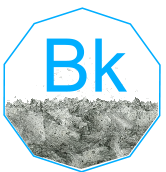Berkelium

Berkelium (Bk)
General Information
- Symbol: Bk
- Atomic Number: 97
- Atomic Weight: 247 u
- Element Category: Actinide
- Group: N/A (Actinides series)
- Period: 7
- Block: f-block
Physical Properties
- Appearance: Silvery metallic, easily oxidizes in air
- Density: 14.78 g/cm³
- Melting Point: 986 °C (1807 °F)
- Boiling Point: 2627 °C (4761 °F)
- Phase at STP: Solid
- Electron Configuration: [Rn] 5f⁹ 7s²
- Oxidation States: +3 (most common), +4
Chemical Properties
- Reactivity: Berkelium is highly reactive, especially in its +3 oxidation state. It reacts with oxygen, steam, and acids.
- Compounds: Forms compounds such as berkelium dioxide (BkO₂), berkelium(III) chloride (BkCl₃), and berkelium(III) nitrate (Bk(NO₃)₃).
Uses and Applications
- Scientific Research: Used primarily in scientific research to study the properties of actinides and heavier transuranium elements.
- Synthesis of Heavier Elements: Berkelium has been used in the synthesis of other elements, such as tennessine (element 117).
Occurrence and Extraction
- Natural Occurrence: Berkelium does not occur naturally and is a synthetic element.
- Production: Produced in nuclear reactors by bombarding curium or americium with neutrons.
Isotopes
- Stable Isotopes: Berkelium has no stable isotopes.
- Radioactive Isotopes: The most common isotopes are Berkelium-247 (half-life of 1,380 years), Berkelium-249 (half-life of 330 days), and Berkelium-248 (half-life of 9 years).
Safety and Handling
- Hazards: Berkelium is highly radioactive and poses significant health risks. It can cause radiation poisoning and cancer if inhaled or ingested.
- Precautions: Handle with extreme care, using appropriate protective equipment and working in controlled environments. Proper disposal of radioactive materials is crucial.
History
- Discovery: Discovered by Stanley G. Thompson, Glenn T. Seaborg, Kenneth Street, and Albert Ghiorso in 1949.
- Name Origin: Named after the University of California, Berkeley, where it was discovered.
Additional Facts
- Crystal Structure: Hexagonal close-packed (hcp)
- Magnetic Properties: Paramagnetic
- Thermal Conductivity: Unknown
- Electrical Resistivity: 0.69 µΩ·m at 0°C
Summary
Berkelium is a synthetic element used primarily in scientific research. It is produced in nuclear reactors and is known for its role in the synthesis of heavier elements. Discovered in 1949, berkelium requires careful handling due to its high radioactivity.
40 Question and Answer Pairs About Berkelium
What is the atomic number of Berkelium?
- 97
What is the symbol for Berkelium?
- Bk
What is the atomic weight of Berkelium?
- 247 u
In which group of the periodic table is Berkelium found?
- Actinides series (no specific group)
What period is Berkelium in?
- Period 7
What block does Berkelium belong to?
- f-block
What is the density of Berkelium?
- 14.78 g/cm³
What is the melting point of Berkelium?
- 986 °C (1807 °F)
What is the boiling point of Berkelium?
- 2627 °C (4761 °F)
What is the electron configuration of Berkelium?
- [Rn] 5f⁹ 7s²
What are the common oxidation states of Berkelium?
- +3 (most common), +4
What is the appearance of Berkelium?
- Silvery metallic
Is Berkelium reactive with air?
- Yes, it easily oxidizes.
Name a compound of Berkelium.
- Berkelium dioxide (BkO₂)
What is a common use of Berkelium in scientific research?
- To study the properties of actinides.
How is Berkelium used in the synthesis of heavier elements?
- Used in the synthesis of elements such as tennessine.
How is Berkelium typically produced?
- By bombarding curium or americium with neutrons in nuclear reactors.
What is the most common isotope of Berkelium for research?
- Berkelium-249
How is Berkelium extracted?
- Produced synthetically in nuclear reactors.
What safety hazard is associated with Berkelium dust?
- It is highly radioactive and poses significant health risks.
Who discovered Berkelium?
- Stanley G. Thompson, Glenn T. Seaborg, Kenneth Street, and Albert Ghiorso
Where does the name Berkelium come from?
- Named after the University of California, Berkeley.
What is the crystal structure of Berkelium at room temperature?
- Hexagonal close-packed (hcp)
Is Berkelium paramagnetic or diamagnetic at room temperature?
- Paramagnetic
What is the thermal conductivity of Berkelium?
- Unknown
What is the electrical resistivity of Berkelium at 0°C?
- 0.69 µΩ·m
What is the primary oxidation state of Berkelium in its compounds?
- +3
Is Berkelium found as a free element in nature?
- No, it is a synthetic element.
What is the common name of Berkelium(III) chloride?
- BkCl₃
What is a major application of Berkelium in scientific research?
- Studying the properties of actinides and synthesizing heavier elements.
How does Berkelium benefit the synthesis of heavier elements?
- Used as a target material in the production of elements like tennessine.
What is the melting point of Berkelium in Kelvin?
- 1259 K
What group does Berkelium belong to in the periodic table?
- Actinides series
What is the natural abundance of Berkelium-249?
- It is produced synthetically and is not found naturally.
Can Berkelium be used in high-temperature applications?
- Yes, particularly in research contexts.
What is the key property that makes Berkelium valuable in research?
- Its radioactive properties and role in synthesizing heavier elements.
How is Berkelium used in the chemical industry?
- Mainly in research and specialized applications.
What precautions should be taken when handling Berkelium?
- Use appropriate protective equipment to avoid inhalation or ingestion.
What are the health risks associated with Berkelium?
- It can cause radiation poisoning and cancer if inhaled or ingested.
What are the common isotopes of Berkelium used in research?
- Berkelium-247, Berkelium-249, and Berkelium-248.






